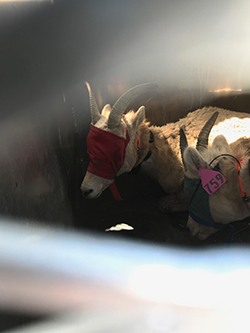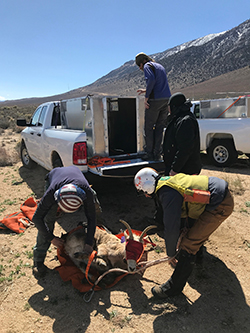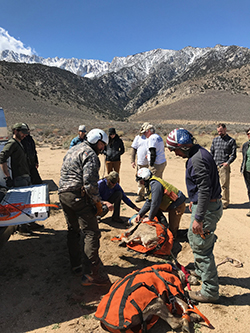
These pregnant females will bolster the population of a newly established herd as well as provide an infusion of fresh genetic material to helps ensure their new herd’s health and long-term survival.

Outfitted with an ear tag and two tracking collars, this ram awaits delivery to a new herd where it’s hoped he will infuse the population with fresh genetics

Among the goals of the Sierra Nevada Bighorn Sheep Recovery Plan is the establishment of 12 viable herds across their historic range. CDFW’s capture and relocation efforts over the years have helped establish 14 herds today across 150 miles of their historic range.

These Eastern Sierra bighorn sheep are being prepared for their flight to a new home and new herds.
Seven animals.
Can just seven Sierra Nevada bighorn sheep really make much of an impact on the species’ future?
CDFW scientists believe so, which is why they came away pleased with the results of their annual spring helicopter capture this past March. Limited to three days of work due to strong winds and bad weather, the effort resulted in the capturing, collaring and relocation of seven sheep to new herds high in the Eastern Sierra.
Although the final chapters have yet to be written, the saga surrounding the Sierra Nevada bighorn sheep, one of the rarest large mammals in North America, is shaping up to be a 21st century wildlife success story.
A unique subspecies found only in the Sierra Nevada, historic populations numbered in the thousands. Their steep population decline began in the 1800s as a result of competition from livestock grazing, unregulated hunting and the transmission of disease from domestic sheep. Drought and predation further hammered their numbers, which dwindled to about 100 animals in just three herds by the mid-1990s. State and federal officials declared them endangered in 1999.
Today, less than 20 years removed from those dramatic listings, there are 14 different Sierra Nevada bighorn sheep herds spread across 150 miles of the iconic mountain range. About 600 bighorn sheep are now eking out a living atop the Sierra’s highest peaks. Sierra Nevada bighorn sheep are present once again inside Yosemite National Park and Sequoia National Park after a 100-year absence.
CDFW’s role is itself unique as a state agency tasked with leading the recovery of a federally listed endangered species. Sierra Nevada bighorn sheep are recolonizing their historic range – with a major assist from CDFW’s twice-yearly captures, collaring and strategic “translocations.”
This spring, three males and four pregnant females were captured from two established herds and translocated to two newly reintroduced herds – one along their western range inside Sequoia National Park and another herd in Inyo County at the southernmost extent of their range.
“Whenever we start these new herds, we like to move a minimum of 20 females as well as additional rams over time,” explained Tom Stephenson, a CDFW senior environmental scientist based in Bishop and the leader of the Sierra Nevada Bighorn Sheep Recovery Program. “At that point, we feel the population has enough animals to begin growing at a high enough rate and also has sufficient genetic diversity.”
Before the animals are relocated, a CDFW team records their vital statistics. Ultrasound machines are used to measure body condition and determine pregnancy status. The animals are outfitted with identifying jewelry – color-coded ear tags, VHF and GPS collars that allow biologists to identify them and track their movements for years in some cases.
All the high-tech, intensive monitoring has paid dividends with new appreciation and understanding. Once believed to always migrate to lower elevations in the winter, CDFW scientists have learned that many sheep ride out the Sierra Nevada’s inhospitable winters at 11,000- to 14,000-foot elevations.
“They are really tough,” Stephenson said. “But they’re able to do that because they put on large amounts of body fat in the summer when they’re on quality habitat. They are essentially hibernating standing up in the alpine. They’ve got an environment up there that is wind-scoured so they can find some food. They’re not having to move around much, and they’re relatively free from predators when they’re up in those altitudes in the winter time.”
Not every sheep captured is relocated.
Helicopter crews this spring attempted unsuccessfully to capture rams in the northernmost part of their range, collar them and return them to their same herds. CDFW biologists are keeping close tabs on the Mount Warren Herd near Lee Vining in Mono County in particular and its proximity to domestic sheep grazing on public land. Sierra Nevada bighorn sheep are disease-free and CDFW biologists want to keep them that way.
While populations have met or exceeded some recovery goals, eliminating disease – or the risk of disease – remains a significant benchmark and key to delisting or down-listing the species from endangered status.<
“There are a lot of bighorn sheep populations throughout the West that continue to struggle with disease,” Stephenson said. “So we’ve worked really hard with public land managers as well as private individuals in the Eastern Sierra to try and ensure our bighorn sheep don’t come into contact with domestic sheep.”
CDFW photos courtesy of Andrew Di Salvo. Top Photo: A helicopter crew delivers four bighorn sheep to CDFW's base camp where vital statistics were recorded, blood was taken, and the sheep were outfitted with identifying ear tags and tracking collars.